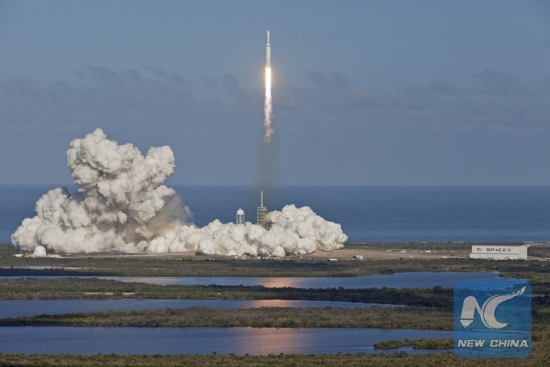
A SpaceX Falcon Heavy rocket lifts off from Florida's Kennedy Space Center, the United States, Feb. 6, 2018. (Xinhua/NASA)
The spectacular liftoff of the SpaceX Falcon Heavy rocket on Tuesday was clouded by one puzzlement: part of the payload was a car. A red Tesla convertible with the top down and a mannequin named Starman in a spacesuit strapped into the driver's seat, to be exact.
"Payload will be my midnight cherry Tesla Roadster playing Space Oddity. Destination is Mars orbit," SpaceX founder and CEO Elon Musk tweeted. "Will be in deep space for a billion years or so if it doesn't blow up on. On the face of it, this seems like the ultimate ego trip — sure, it's his rocket, his car, his nickel. For some reason, the first thing that comes to mind is the Roman emperor Caligula making his favorite horse a consul of Rome.
"I love the thought of a car drifting apparently endlessly through space and perhaps being discovered by an alien race millions of years in the future," Musk tweeted more recently.
Indiana University chemist William Carroll told LiveScience that the car, if it is really heading out to Mars orbit, probably won't make it through the first year of its trek. Aside from the blistering radiation from the sun, there are mine fields of space junk and asteroids large and small to pass through.
Even if it were a self-driving car, it would have trouble negotiating a house-sized rock.
Little by little the organic parts of the car — the non-metallic components — will disintegrate as their chemical bonds shatter, Carroll explained. Before long it will be an aluminum frame floating through the void — hardly a great promo for aliens shopping for a car.
For now, the image of the mannequin with its hand on the steering wheel and planet Earth in the background has gone viral and created a sensation, probably rekindling enthusiasm for the wonders of space exploration, maybe even inspiring a few future astronauts.
You can view a live feed from over Starman's shoulder online. Great view, but it does look pretty lonely out there. And when you get right down to it, isn't this stunt just adding to the debris we've already strewn up there?
According to the US Strategic Command, there are 17,852 artificial objects in orbit above the Earth. That number includes 1,419 operating satellites and telescopes; the rest is space junk, space trash, space garbage — call it what you will. That's just the stuff big enough to track. Debris ranging in size from a half inch to about a foot, they estimate, numbers up to about 170 million items.
From old dead satellites and spent rocket stages to clouds of frozen coolants and flakes of paint, the debris is a hazard to spacecraft and telescopes that can't be covered with shields.
According to Lockheed Martin's research there are about 200 threats to orbiting satellites every day. It's a jungle up there.
The garbage field continues to grow. The European Space Agency calls it a "deadly cascade".
Last month, researchers at the Air Force Engineering University in China published a paper describing how space-based lasers could be used to zap space junk into smaller, less threatening objects.
They even conducted a simulation that "provides necessary theoretical basis for the deployment of space-based laser station and further application of space debris removal by using space-based laser".
Putting any kind of zappers up in orbit does not seem like a very good idea. NASA has been looking into other ways to tidy up the mess, including magnets to draw objects out of orbit or deploying giant nets to scoop it up.
What the whole world is watching for now is the predicted break up and "de-orbiting" of China's oldest space station, the Tiangong-1, which was launched in 2011 and was predicted to fall to Earth late last year.
"Based on our calculation and analysis, most parts of the space lab will burn up during falling," Wu Ping, deputy director of China's manned space engineering office said at a news conference in September 2017.
Now, with its telemetry cut making a controlled drop impossible, the 8.5-ton object, which is moving at 20,000 miles per hour, could fall anytime, anywhere.
Unless it has a fender-bender with a dummy driving a midnight cherry-red sports car.


















































